Chemical fears (part of 2)
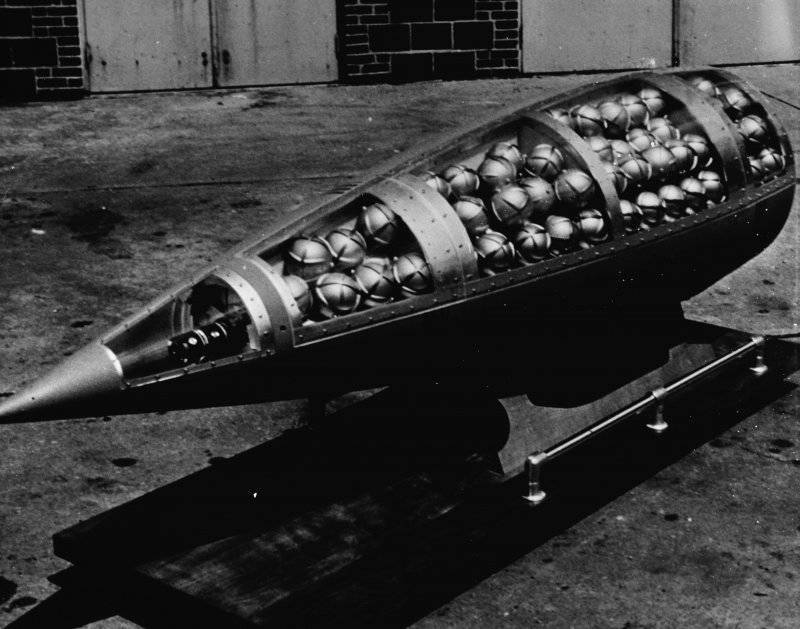
Layout of a chemical cluster warhead of a tactical missile
In the second half of the 20 century, chemical weapon became a cheap alternative to nuclear for third world countries, where various kinds of authoritarian regimes came to power. Chemical weapons on the battlefield are of value only in the event of their massive use. Cluster aerial bombs are best suited for this. aviation instruments, multiple launch rocket systems, large masses of barrel artillery. A special threat is the warheads of ballistic missiles equipped with toxic substances when used in large cities. In this case, the number of victims among the civilian population can go up to thousands.
The threat of using against the civilian population least protected from warfare, non-selectivity, excessive suffering caused by chemical weapons, and the end of the Cold War all led to the conclusion of the International Convention on the Prohibition of Chemical Weapons in 1993, which entered into force on April 29 1997 of the year. But the main reason for abandoning chemical arsenals in the United States and Russia was that the chemical weapons created for the “big war” became too troublesome and costly, with no obvious advantages over conventional weapons. Specially prepared storages and specialists were required, the containers with mustard and lewisite, refueled during the Second World War, corroded and were unsafe, the military was put under a lot of pressure in the form of negative public opinion, and as a result it became too burdensome for the military to contain. In addition, in modern conditions, when the risk of global war has fallen to a minimum, nuclear weapons as a means of deterring a potential enemy have become more than enough.
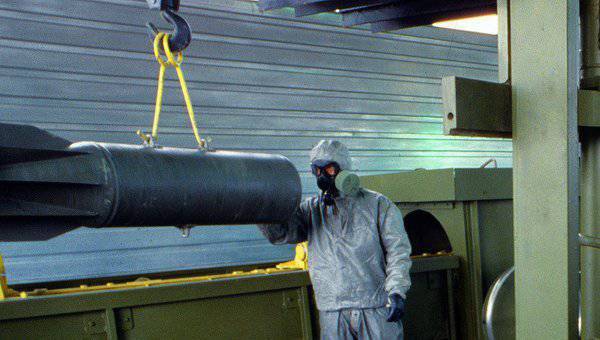
As is known, the largest volumes of CWA were in Russia (40 thousand tons of toxic substances) and the USA (28 572 tons of toxic substances). Most of the (32 200 tons) of warheads accumulated in the USSR were FOW: sarin, soman, an analogue of VX, and the remainder consisted of skin-abscess poisons: mustard gas, lewisite, and their mixtures. In the USSR, neuroparalytic poisonous substances were loaded into ammunition corps ready for use. The mustard and lewisite were almost completely stored in tanks, the entire 2% of lewisite was in ammunition. Around 40% of the mustard-lewisite mixtures in the USSR was stored in ammunition. In the US, more than 60% DOM (mustard and mixtures based on it, VX, sarin) were in tanks, the rest in the loaded ammunition. To date, the parties have practically completed the destruction of their chemical arsenals, which was confirmed by mutual inspections of the enterprises where recycling was carried out and the storage sites of the DOM.
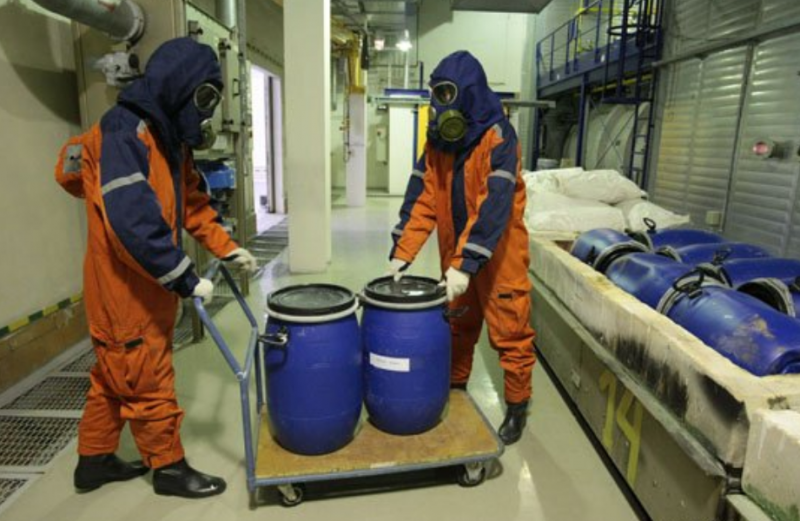
The Convention on the Prohibition of Chemical Weapons, which entered into force on April 29 1997, was joined by 188 countries. Eight states remained outside the Convention, two of which - Israel and Myanmar - signed the Convention, but did not ratify it. Six more countries - Angola, Egypt, North Korea, Somalia, Syria, South Sudan did not sign. To date, North Korea has the largest reserves of toxic substances, which, of course, is of concern to neighbors.
Among the world community there is a well-founded fear of chemical weapons and their complete rejection as a barbaric means of armed struggle. The presence of chemical weapons in the Syrian Arab Republic almost became a pretext for the West to unleash aggression against this country. In Syria, the presence of chemical arsenals and means of delivery was considered as a kind of insurance against an attack by Israel with nuclear weapons. In the 2012 year, the Syrian military had about 1300 tons of combat agents, as well as more than 1200 not equipped with bombs, missiles and shells. In the past, accusations of the leadership of Iraq in the presence of weapons of mass destruction have become the formal pretext for attacking this state of Western countries under the leadership of the United States.
With the mediation of Russia 13 September 2013, Syrian President Bashar al-Assad signed an act of abandoning chemical weapons, their full utilization and subsequent ratification by Syria of the Convention on the Prohibition of Chemical Weapons in full. 23 June 2014 of the year, it was announced that the last consignment of BOV was removed from the SAR territory for subsequent destruction. 4 January 2016, the Organization for the Prohibition of Chemical Weapons announced the complete destruction of chemical weapons in Syria.
It would seem that the topic of Syrian toxic agents should be closed, but materials about the alleged use of poison gas by the Syrian government forces have been repeatedly published in the Western media. Indeed, international experts have repeatedly recorded the facts of the use of neuroparalytic BOV in Syria. In this case, the expense of the victims went to dozens of people. Western countries, as always, were quick to blame all the sins on the regular Syrian army, but detailed studies in the places where poisonous substances were used showed that sarin was filled with hand-made shells with a poisonous substance. In addition, during the laboratory examination of fragments of ammunition filled with sarin, it turned out that this substance was low-purity and contained a large number of extraneous chemical compounds, which clearly indicates the non-industrial, artisanal nature of production. In July 2013, information appeared about the discovery of several underground laboratories in Iraq, where Islamists carried out work on the creation of toxic substances. With high probability, it can be assumed that sarin-equipped home-made rockets hit Syria from neighboring Iraq. In this regard, it is worth recalling that the Turkish secret services detained Syrian militants in the summer of 2013, who were trying to transfer containers with sarin across the Turkish-Syrian border, and about phones with video recordings found on the killed Islamists, in which terrorists test toxic substances on rabbits.
Syrian representatives have repeatedly shown video footage, which recorded captured from terrorists illegal laboratories for the production of CEL. Apparently, the provocations of the militants with sarin failed, and the accusation of using chemical weapons by government forces against the “peaceful population” failed. However, attempts to use poisonous substances are not abandoned by terrorists. In this regard, Syria serves as a kind of ground for them. Making sarin and equipping them with ammunition requires technological and laboratory equipment of a fairly high level. In addition, unauthorized sarin leak is fraught with very serious consequences for the "laboratory technicians" themselves. In this regard, if you believe the Russian media, the militants have recently used chemical munitions filled with chlorine, mustard gas and white phosphorus. If the first two substances, although with certain restrictions, which will be discussed below, can really be considered poisonous, then how white phosphorus got into this company is completely incomprehensible. However, the case is most likely in the ignorance of journalists who take to cover the problems of chemical weapons and in the ongoing information and psychological war.
Perhaps for the average person who does not understand the difference between yperite and white phosphorus, everything is the same, but for people who have an understanding of weapons of mass destruction or at least knowledge of the chemistry school course, the inclusion of phosphorus as a fighting poison is ridiculous. White phosphorus is really poisonous and, when burned, produces smoke, which when combined with water turns into a strong acid, but it is impossible to poison a significant amount of people with phosphorus or its combustion products in a short time. Asphyxiating smoke is only a minor damaging factor. However, anyone who has visited artillery firing or in a zone of full-scale hostilities will confirm that powder smoke and TNT as well do not add health either.
The damaging effect of phosphorus ammunition is based on the tendency of white phosphorus to ignite itself in the open air, its combustion temperature, depending on the additional components of the incendiary projectile, is 900-1200 ° С, and it is impossible to extinguish it with water. There are several types of phosphorus ammunition: bombs, artillery shells, rocket launchers for the MLRS, mortar mines, hand grenades. Some of them are intended for the installation of a smoke screen, since phosphorus gives off thick white smoke when burned. So, for example, white phosphorus is used in the smoke cloud grenade launcher “Tucha”, which is installed on domestic armored vehicles, but nobody considers it a chemical weapon. The Soviet army was armed with incendiary air bombs, as well as projectiles and mines, in which white phosphorus was a flaming element.
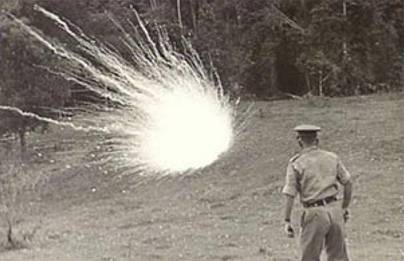
White phosphorus was used on a noticeable scale during the First World War, then all the warring parties actively used phosphorus bombs, mines and shells during the Second World War. So, for example, in the USSR, a solution of white phosphorus in carbon disulfide (self-igniting liquid KS) equipped glass bottles and ampoules used against German tanks. In the postwar period, incendiary phosphorus munitions were available in the armies of all militarily developed countries and were repeatedly used as a powerful incendiary in combat operations. The first attempt to limit the use of phosphorus munitions was made in 1977 as part of the Additional Protocols to the 1949 Geneva Convention for the Protection of Victims of War. These documents prohibit the use of ammunition with white phosphorus if civilians are therefore in danger. However, the United States and Israel did not sign them. When used against military targets located “inside or in the vicinity of populated areas”, weapons containing white phosphorus are prohibited under international agreements (Protocol III to the Geneva Convention of 2006 on specific types of conventional weapons). It is in this context that the use by the Syrian armed opposition of phosphorus shells and mines in settlements should be considered.
Unlike white phosphorus, chlorine is indeed recognized as a choking chemical agent. Under normal conditions, this greenish-yellow gas is heavier than air, as a result of which it spreads along the ground and can accumulate in the folds of the ground and basements. However, to achieve a significant combat effect with chlorine, the use of this gas must be carried out on a large scale. During the First World Chlorine was mainly used by the gas balloon method. Equipping them with artillery shells and mines was considered ineffective, since a simultaneous volley of hundreds of large-caliber guns was required to create the necessary concentration of gas in the area. For what the terrorists fill them with shells, it is not clear, because there are no hundreds of heavy artillery barrels at their disposal, concentrated in a narrow sector of the front. With a single use of projectiles, mines and missiles, the equipment of their conventional explosives gives a much greater striking effect. In addition, due to its chemical activity, chlorine destroys the metal walls of the projectiles loaded with them in artisanal conditions, which leads to leakage and limits the shelf life of such ammunition.
Mustard gas is much more dangerous than chlorine in comparison with chlorine. For a long time, mustard gas, also known as “mustard gas”, was considered the “king” of chemical warfare agents. At temperature 20 ° С, mustard gas is a liquid. Due to the fact that the evaporation of mustard gas under normal conditions is very slow, it is able to maintain its damaging effect for several days, permanently infecting the area. Mustard gas is chemically stable and can be stored in metal containers for a long period of time, and it is also cheap to produce.
Mustard gas is called a blistering substance, since the main lesions occur when exposed to the skin. But this substance acts slowly: if a drop of mustard gas is removed from the skin no later than 3-4 minutes and the place is treated with a neutralizing compound, then there may not be a lesion. In case of lesions with mustard, pains - itching and redness - do not appear immediately, but after 3-8 hours, blisters appear on the second day. The damaging effect of mustard gas is highly dependent on the temperature at which it is used. In hot weather, poisoning with mustard gas is much faster than in cold. This is explained by the fact that with an increase in temperature, the rate of evaporation of mustard gas rapidly increases, besides, sweaty skin is more susceptible to the damaging effects of its vapors than is dry. With a strong degree of damage, blisters form on the skin, and later on, deep and long-term ulcers appear on the spot. Ulcers can heal from several weeks to several months. In addition to the skin, mustard gas can have a toxic effect by inhaling its vapors. Large concentrations of mustard gas in the air can cause general body poisoning, nausea, vomiting, fever, cardiac abnormalities, changes in blood composition, loss of consciousness and death. But the mortality rate for poisoning with mustard gas in combat conditions is small (a few percent). In this regard, many experts in the field of CEL attribute mustard gas to "crippling" toxic substances: a significant part of the victims from the effects of this poison for the rest of their lives were disabled.
Compared with the nerve agents, mustard gas is fairly easy to obtain in several ways and does not require complex laboratory and technological equipment. Manufacturing components are available and inexpensive. For the first time mustard gas was obtained 1822 year. In the newest stories Russia recorded cases of production of mustard gas at home. It is quite predictable that the Syrian "barmalei" showed great interest in this CWA. However, the militants do not have the necessary means for the proper application of mustard gas. Mustard compared to fowl to achieve combat effectiveness requires more massive use. Poured aviation instruments are best suited for spraying mustard gas. In this case, infection of large areas is possible. When equipment with mustardite artillery shells, mines and missiles to achieve the same effect is required to make an indecently large number of shots.
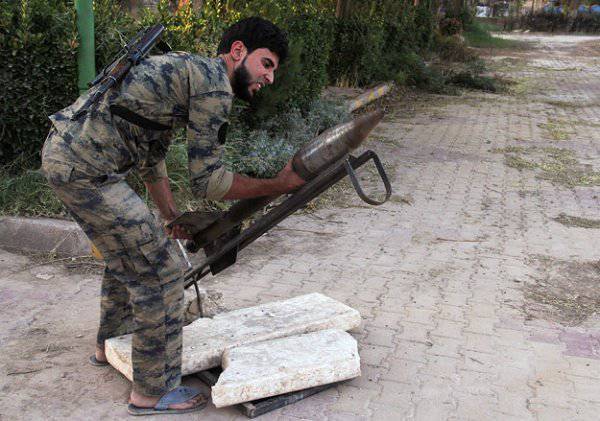
It is clear that the Islamists have no aircraft and a large number of artillery systems and significant stocks of mustard gas. Projectiles with this substance can be used in urban conditions to displace the enemy from their positions, because to be in the source of infection, even if it is a slowly acting poisonous substance, is deadly dangerous. But in any case, the use of single-charge amber mustard, which we observed during the battles for Aleppo, cannot be of any use militarily. On the contrary, the use of combat poisons within the city limits takes those who apply them beyond the rules of warfare and turns them into war criminals. It is hard to say whether the “fighters of the armed opposition” understand this. Practice shows that extremists and militant religious fanatics are capable of taking any step to achieve their goals.
Under current conditions, chemical weapons available to the armed Syrian opposition, due to their small size and the impossibility of competent use, cannot influence the course of hostilities. However, toxic substances as sabotage and terrorist weapons are of great interest to various terrorist groups and extremist organizations. Particularly dangerous are poisonous substances in the event of a chemical attack in a large metropolis with a high concentration of population.

We can recall the sarin attack in the Tokyo subway 20 in March 1995 of the year, carried out by members of the Aum Shinrikyo sect. Then, quietly placing liter bags of liquid sarin on the floor of the carriages, they pierced them as they left the carriage. 13 people were fatally poisoned; more than 5500 people suffered. Poisoning caused sarin fumes, but if the terrorists were able to spray it - the number of victims would be immeasurably greater.
At the same time, despite the accession of the majority of states to the Convention on the Prohibition and Elimination of Chemical Weapons, research in this area has not ceased. Beyond the agreement, there were many groups of substances that are not formally BWA, but have similar properties. At present, “law enforcement structures” widely use irritants, which are tear and irritant substances, to combat mass protests. At certain concentrations, irritants sprayed in the form of an aerosol or smoke cause intolerable irritation of the respiratory organs and eyes, as well as skin of the whole body. This group of substances was not included in the chemical weapons by its definition given in the text of the chemical convention 1993 of the year. The convention only calls on its participants not to use chemicals of this group during combat operations. However, the newest irritants, due to their high efficiency, may well be used as functional analogues of poisonous substances of asphyxiation. In the case of the use of tear and irritating gases in combination with emetics - substances that cause uncontrolled vomiting - the enemy soldiers will not be able to use gas masks.
Narcotic analgesics, morphine and fentanyl derivatives, are the closest to the neuroparalytic toxic substances by the nature of the lesion from non-banned drugs. In low concentrations, they cause an immobilizing effect. At higher dosages, the most active of the narcotic analgesics, according to their level of action, achieve the effect of neuroparalytic substances, and, if necessary, are fully capable of replacing non-conventional CWA.
The case of using narcotic analgesics, involving the seizure of 26 hostages by October 2002 on October 2 in Dubrovka in Moscow, also known as “Nord-Ost”, received wide response. In the course of a special operation on the official application of the FSB, at Dubrovka, “special-prescription based on fentanyl derivatives” was applied. Specialists from the laboratory of scientific and technological foundations of security in Salisbury (UK) believe that the aerosol consisted of two analgesics - carfentanil and remifentanil. Although the operation ended with the destruction of all the terrorists, and the explosion was avoided, out of the hostages taken by 916, according to official data, 130 people died as a result of the gas.
It is safe to say that, despite the declared abandonment of chemical weapons, toxic substances have been used, are being used and will be used as weapons. However, from the means of destruction on the battlefield, they turned into a tool for “appeasing” the protesting masses and an instrument for carrying out covert operations.
Based on:
http://www.hab.kp.ru/daily/26243.3/3124150/
http://pro-tank.ru/tanki-v-bou/posobie-for-tankist/119-glava-6-voenno-himitheskoe-delo/423-1-boevie-himicheskie-veshestva
N.S. Antonov. CHEMICAL WEAPON ON THE TURN OF THE TWO CENTURIES

Information